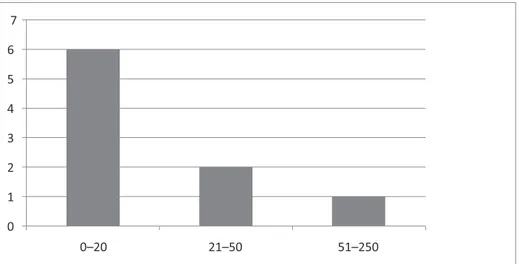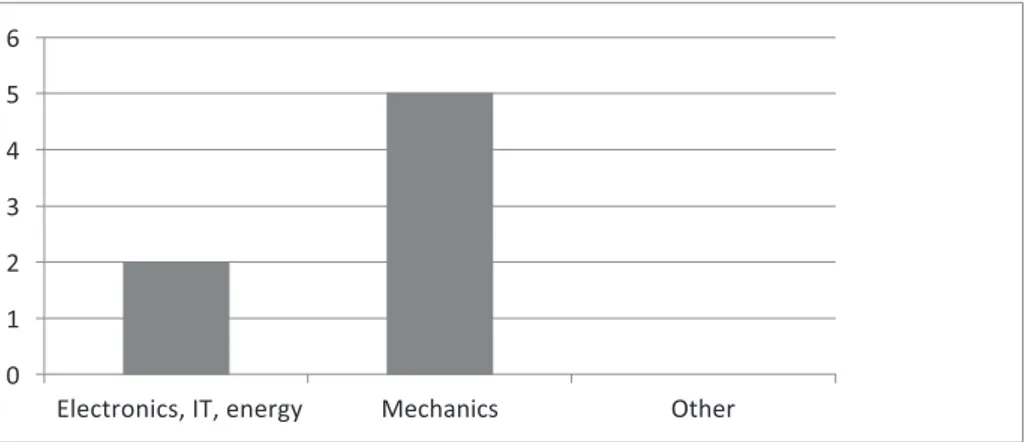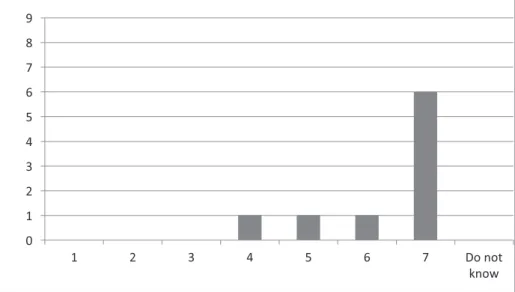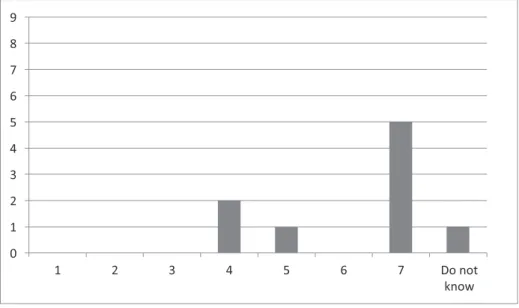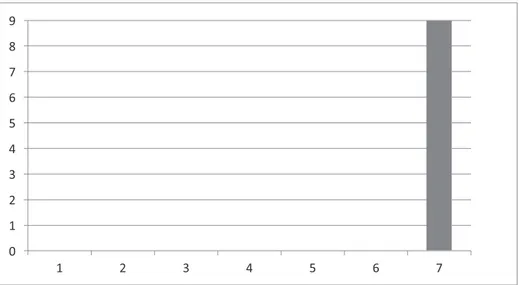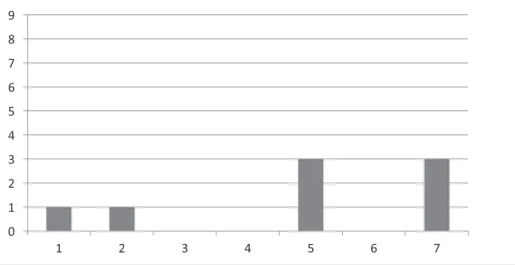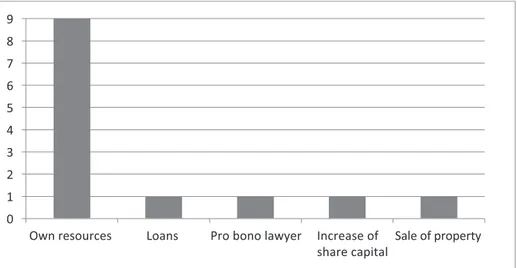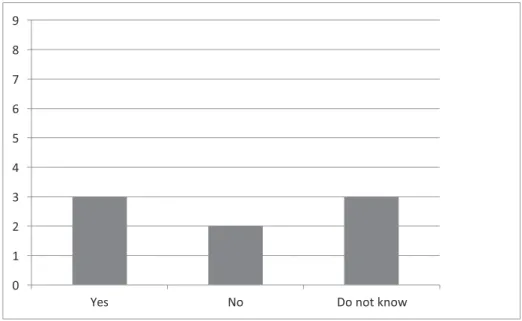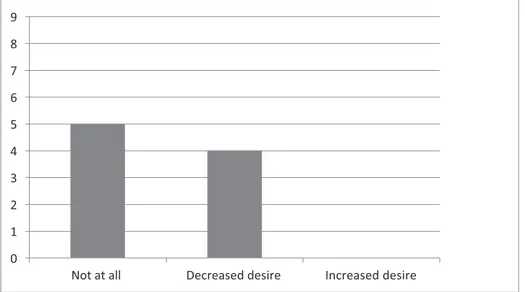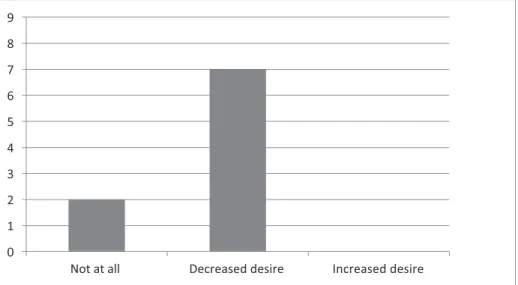Swedish Patent Litigation Survey of Small and
Medium-sized Enterprises
By Professor Per-Olof Bjuggren, Professor Bengt Domeij and
Research assistant Anna Horn*
What are the opinions of small and medium-sized enterprises with experience of Swedish patent litigation? We offer description and analysis from a 2016 inter-view survey of nine small and medium-sized enterprises that had been involved in Swedish patent litigation on infringement and/or invalidity. Our results show that the companies are of the opinion that the proceedings were too slow and costly. They financed the litigation mainly with their own resources. Insur-ance played only a minor role. We also find that the proceedings seem to have affected their position in the market in terms of customers, suppliers and banks. Half the small and medium sized companies after the litigation had a reduced propensity to patent and almost all are less inclined to engage in future Swedish patent litigation. The critical nature of most comments is typical, though, for small companies that have been involved in litigation, usually a difficult and dis-ruptive experience for all. It should also be said that the comments predate the introduction of the new Swedish Patent and market courts.
1. Data
Companies selected for this study were small or medium-sized enterprises with recent experience of Swedish patent litigation. Small-sized enterprises have less than 50 employees and medium-sized enterprises have less than 250 employees. The companies in the sample were identified from the registers at Stockholm District court (the exclusive fora for patent cases in Sweden) and had been parties to litigation on patent infringement and/or invalidity initiated after year 2000. For the firms to be included the litigation had to have reached a final judgment. Companies that settled before a first judgment are excluded because they have less experience. The aim was to identify respondents with recent and detailed
* Per-Olof Bjuggren, Professor of Economics at Jönköping International Business School and working at the Ratio Institute. Bengt Domeij, Professor in Private law, Uppsala University and associated researcher at Ratio Institute. Anna Horn, jur. kand. at law firm IPQ IP Specialists. We are all very thankful for the financial support received from VINNOVA, the Ratio institute and the Romanusfonden that has enabled us to perform the work resulting in the present article. We also especially want to thank the Swedish Inventors’ Society, SUF, that assisted us with the wording of the question template.
litigation experience. Patent litigation was a new experience for all of the com-panies in the sense that it was their first patent case in Swedish courts.
Selection of the companies started in the data base we created for our 2015 study on Swedish patent litigation with cases initiated 2000 to 2008.1 We
deter-mined how many employees each company had. The small and medium-sized enterprises in the earlier study were supplemented with parties from cases filed between 2009 and 2016. We also used the journal Patenteye to ascertain, as far as possible, that all patent cases with small and medium-sized enterprises had been identified.
The selection lead to a sample of 30 companies. They were contacted and asked if they were willing to participate in a short telephone interview con-cerning their Swedish patent litigation. Out of the 30 companies nine agreed to be interviewed. 21 companies declined. 11 said that no employee involved in the patent litigation was still at the company. Eight companies replied that they were not interested in participating in the study. Two companies were no longer actively trading. The nine companies willing to participate had their headquarters in Sweden. A majority were small or very small companies (Figure 1):
Figure 1. Number of employees in the nine interviewed companies
The interviewees worked mainly in mechanics, IT or electronics (Figure 2):
1 See P-O. Bjuggren, B. Domeij and A. Horn, Swedish Patent Litigations in Comparison to
Figure 2. Industry of the Responding Companies
The individuals interviewed held leading positions, mostly identifying themselves as owners. One identified himself as a CEO and three as technical managers (Figure 3):
Figure 3. The individual respondents
Interviews were made by phone except one that was conducted by a meeting in person. The interviews were recorded and later transcribed. The length of the telephone interviews varied between 10 and 15 minutes and the interview made in person lasted for one hour.
Five of the nine companies interviewed had been sued for infringement. From the court records we have determined that all these five companies prevailed in the litigation, either after an invalidation of the patent in suit or by the court finding that the patent had not been infringed by them. Four of the interviewees were holders of the patents in suit and had claimed that their patents had been infringed. Out of the patent holders one was successful (infringement was deter-mined), but three of the patent holders lost the litigation either because the patent
in suit was invalidated or it was concluded that it had not been infringed. Thus, six of the nine small and medium-sized enterprises were ultimately successful in the litigation.
The response rate was 30 percent (nine out of 30 companies). The aim of a non-response analysis is to assess whether the responses in a survey are skewed because a particular sub-group has been more willing to respond than other sub-groups. If the responses are skewed in some respect it is important to con-sider how the answers may be unrepresentative. Below, we mention two tests to determine whether the survey yielded responses representative for small and medium-sized enterprises that have been parties to Swedish patent litigation.
The companies interviewed were mainly in the mechanics and electronic industries. A crude comparison with the total sample of 30 firms in our sample shows that this is representative for small and medium-sized enterprises involved in Swedish patent litigation.
A particular risk in surveys about litigation is that winners are more prone to answer questions than losers. It raises the possibility that our interviewees might be unrepresentative of the broader population of small and medium-sized enter-prises that have been in Swedish patent litigation. We have seen that of our nine respondents six prevailed in the litigation, either as non-patent holders (five com-panies had either a court finding of non-infringement or that the patent asserted against them was invalidated), or as patent holders (one company had an infringe-ment established by court). Of our nine respondents three, we have determined, lost the litigation. Two losing companies realized that their patent had not been infringed (outside the scope of protection) and one losing company suffered its patent being invalidated. Thus, two thirds of the interviewed respondents were winners and one third of the respondents lost the litigation. The sample is skewed towards winners (each case, by our definitions, had one winner and one loser and a non-biased sample would have had an even distribution of winners and losers). The tendency for winners to be more willing to discuss a case and losers to avoid discussions is to be expected. Winners are presumably more positive about litigation than losers. The conclusion therefore is that the interviewed small and medium-sized enterprises may be too positive compared to our sample of 30 companies. It is at least unlikely that the respondents are more negative than the total cohort of 30 small and medium-sized enterprises that recently have been in Swedish patent litigation.
2. Litigation duration and its effects
In our earlier study we concluded that patent litigation in Sweden lasted longer – from filing of suit to a first ruling on the merits of the case – compared to patent litigation in Germany, UK, France and the Netherlands.2 The median time in
an infringement case before a first final judgement was 35.5 months in Sweden,
2 P-O. Bjuggren, B. Domeij and A. Horn, Swedish Patent Litigations in Comparison to European,
compared to 9.2 months in Germany, 11.0 moths in UK, 9.8 months in Holland and 19.8 months in France.
We asked the respondents to grade their views on procedure on a scale with the end points “very fast” and “very slow” (Figure 4). A majority of the firms found the proceedings to be very slow. Six out of nine companies responded “very slow”. One firm mentioned that their case had lasted 8 years. Three others mentioned that their cases lasted for more than 5 years. Interestingly, cases for the interviewed firms lasted longer than the median in our earlier study. Possi-bly, a lack of human or financial resources at small and medium-sized enterprises prolongs the litigation.
Figure 4. What is your view on the time length of the litigation? (1 = Very fast; 7= Very slow)
In the literature a long duration of patent cases is said to be particularly damaging for small and medium-sized enterprises having less financial resources.3 They
are also typically more dependent on the individual products involved in the litigation. A large company spreads the risk involved in litigation over a larger number of products. With comparatively few products it is not surprising that the respondents said that the duration of the litigation had substantial effects on their products (Figure 5):
3 J.O. Lanjouw, M. Schankerman. Protecting Intellectual Property Rights: Are Small Firms
Figure 5. Has the duration of the litigation, hence the time between filing of claims and final judge-ment, affected your company and its products on the market? (1 = Not at all; 7 = To a large extent)
The parties claiming that they had been affected to a large extent were not all defendants in infringement cases. Of the five companies that responded seven (“products to a large extent affected by the duration of litigation”) only two had been sued for patent infringement. Three of the five companies greatly affected were patent holders. It seems that the patent holders felt that the length of the legal process prevented their products from achieving their true potential in the market.
A caveat is warranted. The above responses and the cases they reflect, as already mentioned, precede the new specialized Swedish courts for intellectual property and competition cases, the Patents- and market court and the Patents- and market appeal court, inaugurated on 1 September 2016. The new courts were established to increase specialization of judges and reduce pendency times in litigation.4 Anecdotal evidence suggests that duration of Swedish patent cases
has indeed been reduced with the new courts. 3. Costs and effects in the market
Patent cases have both direct and indirect costs. The direct costs relate to outside experts, witnesses, lawyers engaged in the litigation and any awarded damages. The indirect costs are the time spent internally in preparing the litigation and the effect litigation has on customers and suppliers that may become reluctant to deal with firms involved in patent litigation. Thus, indirect effects include the effort exerted by legal, managerial, engineering, and scientific personnel inside the firm, and other business disruption costs such as loss of goodwill, loss of market share, and disruption of innovative activities. The indirect costs can
often be higher than the direct costs.5 To better understand how the surveyed
firms were affected by the direct and indirect costs of litigation we posed five questions. Firstly, all nine companies thought that the litigation had been very expensive (Figure 6):
Figure 6. What is your view of the costs for the litigation? (1= cost effective/inexpensive; 7= very expensive)
We cannot tell from the survey, but we suspect that respondents interpreted the question to refer to the direct costs of the litigation. The next question was mainly directed towards the company’s ability to develop and market products (indirect costs). Six of the firms reported a substantial negative impact on its position and products in the market due to the patent litigation (Figure 7):
5 J. Bessen, M.J. Meurer, The direct costs from NPE disputes, 99(2) Cornell Law Review p. 390
Figure 7. Have the costs for the litigation, such as lawyer fees, the counterpart’s cost or other costs affected your company’s position and your products on the market? (1 = Not at all; 7 = To a large extend) (One respondent did not answer the question.)
One of the respondents in the interview gave an illustration of the indirect costs that patent litigation can have. The respondent had previously run another com-pany based on two of his patented inventions. The first firm, however, went bankrupt and the estate was bought by a company which became the owner of the two patents. When the founder started his new firm in the same field his old patents were asserted against his new firm. He argued that the patents were primarily used as a tool to cause problems for a growing company in the field, rather than in a genuine belief that an infringement had occurred:
“My new firm was successful and probably the firm that had taken over my two patents thought that I was too successful. They meant that I infringed my two old patents. I did not agree. I had developed an entirely new technology. … It was more important for them to continue with the infringement litigation than to come to an agreement with me. Perhaps they wanted to set an example, a small one person company is easy to target.”
The seven years long case against a larger company affected the respondent’s position in the market:
“[I]t was very difficult because no one wants to do business with someone involved in litigation. … [P]ersonally, I had big debts after a while and was in serious financial trouble. Your creditworthiness is not so good when you are sued by a big company.”
In the end a settlement was reached, after one of the patents in suit had been invalidated by the EPO and the small firm was able to earn money again:
“[I]t all changed with the outcome in the EPO opposition procedure… I managed to pay back my old loans.”
Patent litigation for small and medium-sized enterprises clearly has more severe indirect costs because the firms may be shunned by suppliers, customers or banks, to a higher degree than larger companies. Next, we asked: “How did the firm finance the expected costs for the litigation?” (Figure 8):
Figure 8. How did you finance the expected cost for the litigation?
All respondents stated own resources. Four respondents also mentioned other sources of financing.
Four of the firms mentioned the use of external financial sources, including one that was able to find a pro bono lawyer. The lawyer did not charge anything for his time, which had the bonus of creating a particularly credible defense against a larger company:
“They [the other party, a large firm] realized that as long as I had an attorney [the pro bono lawyer] that worked for me I could continue forever and they would never get back their money [if they won the small company would be bankrupt]. They can destroy me but anything more they will never achieve. But at the same time I think it was impor-tant for them to set an example to other firms that they defended their patents. So they continued the litigation in spite of knowing that they could never get their money back.”
One solution to financing the costs of patent litigation for small and medium-sized enterprises discussed and sometimes also used is patent insurance.6 However, it is
not without difficulties. The adverse selection problems are large as well as the
6 J. O. Lanjouw, M. Schankerman. Protecting Intellectual Property Rights: Are Small Firms
Handicapped?, 47(1) Journal of Law and Economics p. 68 and J. A. Ronspies, Does David need a new sling? Small entities face a costly barrier to patent protection, 4:184-211A John Marshall Review of Intellectual Property Law p. 209 (2004).
problems of having a critical mass of policies that makes it possible to calculate probabilities and premiums. Already today most general insurance policies for businesses provide coverage for expenses incurred in litigation. General business insurances policies on legal costs are, however, normally capped at, say, 200 000 Swedish crones, which is much less than the cost of an average patent case.
Seven firms stated that they had an insurance policy covering legal costs (one firms said it did not have insurance and one company did not answer questions about insurances). All the firms with insurance stated, though, that it had only covered a small part of the costs. One of the firms with insurance for litigation costs can serve as an illustration. The firm had increased its coverage to around 400 000 Swedish crones (normally coverage is around 200 000 Swedish crones). The increased coverage came at a substantial increase in premiums. The total patent litigation costs amounted to 8 million SEK. The actual coverage was also put in question due to a distinction in the policy terms between defensive and offensive litigation:
“There was a lot of fuss that went all the way to some insurance court to determine if it was more than one procedure. There were two different cases, one case where I was defendant and one case where I was the claimant.”
As a follow up about insurance for patent litigation we asked if the firms would have been interested in better insurance coverage, even if it would have raised the premium. As illustrated in Figure 9 the firms were uncertain about the trade-off between a premium increase and the benefits of better coverage. Three firms were in favor of increased coverage at the cost of increased premiums, while two firms were negative to such insurance. Three said that they did not know.
Figure 9. Do you want a better insurance protection, even if it would increase the insurance pre-mium? (Remark: 7 companies answered that they had an insurance against legal expenses.)
The answers cast doubt on the feasibility of solving the problems with patent lit-igation for small and medium-sized enterprises by improved insurance coverage, unless of course the increased protection would be subsidized with public funds. 4. Attitudes towards patents and litigation
The last group of questions in the survey was directed to how the litigation had affected the companies’ willingness to seek new patents and to be involved in future Swedish patent litigation. As seen above, the experience proved difficult for the companies, at least in terms of duration and costs, and as a consequence the firms’ willingness to seek new patents was either unaffected or decreased (Figure 10):
Figure 10. Has the experience of participating in a Swedish patent litigation affected your willingness to seek new patents?
No respondent had an increased desire to patent after experiencing patent lit-igation. That is unsurprising. But if the Swedish litigation was a truly difficult and threatening experience for the firms involved why did their desire to use the patent system not decrease more? One reason could be that five of the nine companies were defendants in infringement cases and the patents in suit were not theirs. Maybe they did not use the patent system before and therefore a negative experience would not change their behaviour. Another explanation is that the alternatives for an innovator, such as secrecy and/or first mover advantages, were not considered good substitutes. One firm told us that:
“[I]t is impossible to enter into negotiations with other firms without patent protection for your ideas.”
Early-stage companies may have no realistic alternative to patenting and are therefore to some extent unaffected by experiencing that enforcement can be difficult. Importantly, though, a majority responded that as a consequence of the litigation they had become less willing to participate in future patent litigation in Swedish courts (see Figure 11):
Figure 11. Has the experience of patent litigation in Sweden affected your willingness to participate in further patent litigation in Swedish courts?
The decreased willingness is probably a function of the duration (Figure 4) and the costs (Figure 6). Maybe the indirect costs came as the greatest negative sur-prise (the distraction, diversion of energy and behavior of suppliers, customers and banks).
The interviews of the nine companies ended with two open questions about how the Swedish litigation systems possibly could be modified in view of their experiences. The first question read: “What advice would you give other com-panies involved in Swedish patent litigation?” Eight firms provided answers to this question. Largely the comments concerned a better awareness of duration, how expensive litigation is and the disadvantage of being a small company. One company said: “Do not get involved unless you have a large capital to spend.” Another advice was “get the best lawyer available even if it costs”. A third pany stressed the importance of considering a possible lost case. Two other com-panies stressed awareness of the risk of losing a property right that is important to you. Finally, other companies said that their advice was not to seek a patent at all with the comment that “it is ridiculous to ever think that you have the sole right to your invention”.
The final question read: “Do you think that the procedure for patent litigation in Sweden should be changed in any way and if so how?” Six firms answered this question. Common features in the responses were that the rights and strength of the patentee should be enhanced in litigation. The technical competence at the courts was believed to be insufficient. The litigation was believed to last too long and that the patent system was designed primarily to serve large companies. Some citations illustrate these views:
“The speed of the litigation process is too slow probably due to … a lack of capacity at the courts.”
“The litigation process should reach the main oral proceedings more quickly and the court should be able to make some decisions much earlier.”
“Better technical competence at the courts is most important. … It would have made litigation simpler.”
“The rights of the patentee definitely have to be strengthened. The lack of interests of the courts to [consider technical] facts is astonishing… [I]t has to do with lack of under-standing in the courts.”
5. Concluding remarks Our main findings are these:
1. Small and medium-sized enterprises with experience of Swedish patent liti-gation are of the opinion that the proceedings are either slow or very slow. The length of the proceedings seems to have seriously affected their position in the market in terms of customers, suppliers and banks.
2. The firms find the litigation costly. They finance the costs mainly with their own resources and insurance plays only a minor role. The costs incurred have affected the companies’ position in the industry. Again, there is evidence of indirect effects on customers, suppliers and banks.
3. Half the small and medium sized companies with patent litigation experience has a reduced propensity to patent thereafter, half is unaffected in terms of patenting. A large majority of the companies are less inclined to engage in future Swedish patent litigation.
We believe that the views identified are representative for small and medi-um-sized enterprises that have been in Swedish patent litigation. The conclusions indicate a playing field in patent litigation tilted against small and medium-sized enterprises. Compared to large corporations, when small-businesses enter into litigation in attempt to enforce patents or defend against claims based on patent rights, such parties are often at a disadvantage due to less resilience regarding busi-ness disruptions. The risks are much higher. While asymmetrical parties create difficulties in all areas of law – consumer/trader disputes immediately come to mind – patent law may be unique in that small companies without prior notice may face a much larger adversary in expensive high-stake litigation. There is less possibility in patent cases for small and medium-sized enterprises to cap in advance their responsibilities so that they are commensurate with the resources. Cases often evolve into bet-your-company-style litigation.
Exacerbating the problems is a likely over-reliance by small and inexperienced companies on the significance of examined and granted patent. Patent holders may rely too much on the determinations made by patent offices and find it surprising that courts can invalidate or (re)interpret patents. It seems to come as a surprise that the patent office determination is not so significant as some pat-ent-inexperienced companies expect.
The difficulties described in this survey are hard to remedy. More or less the same difficulties are experienced in other countries by small and medium-sized
enterprises involved in patent litigation. Persons giving advice to small and medium sized companies should, though, probably stress more the difficulties that the companies may face. The new Swedish courts for patent litigations may have made patent litigation a bit more palatable for entrepreneurs, especially if duration has been reduced. Costs are still a major problem, though. Insurance may be a feasible part of the solution, but probably only with public financial sup-port. Another facilitating measure would be to introduce UK-style non-binding opinions by the Swedish Patent office concerning invalidity and infringement concerning granted patents.7
7 ”Nämnd för bedömning av svenska patentfrågor” (appendix 12.1 to the Swedish Government
